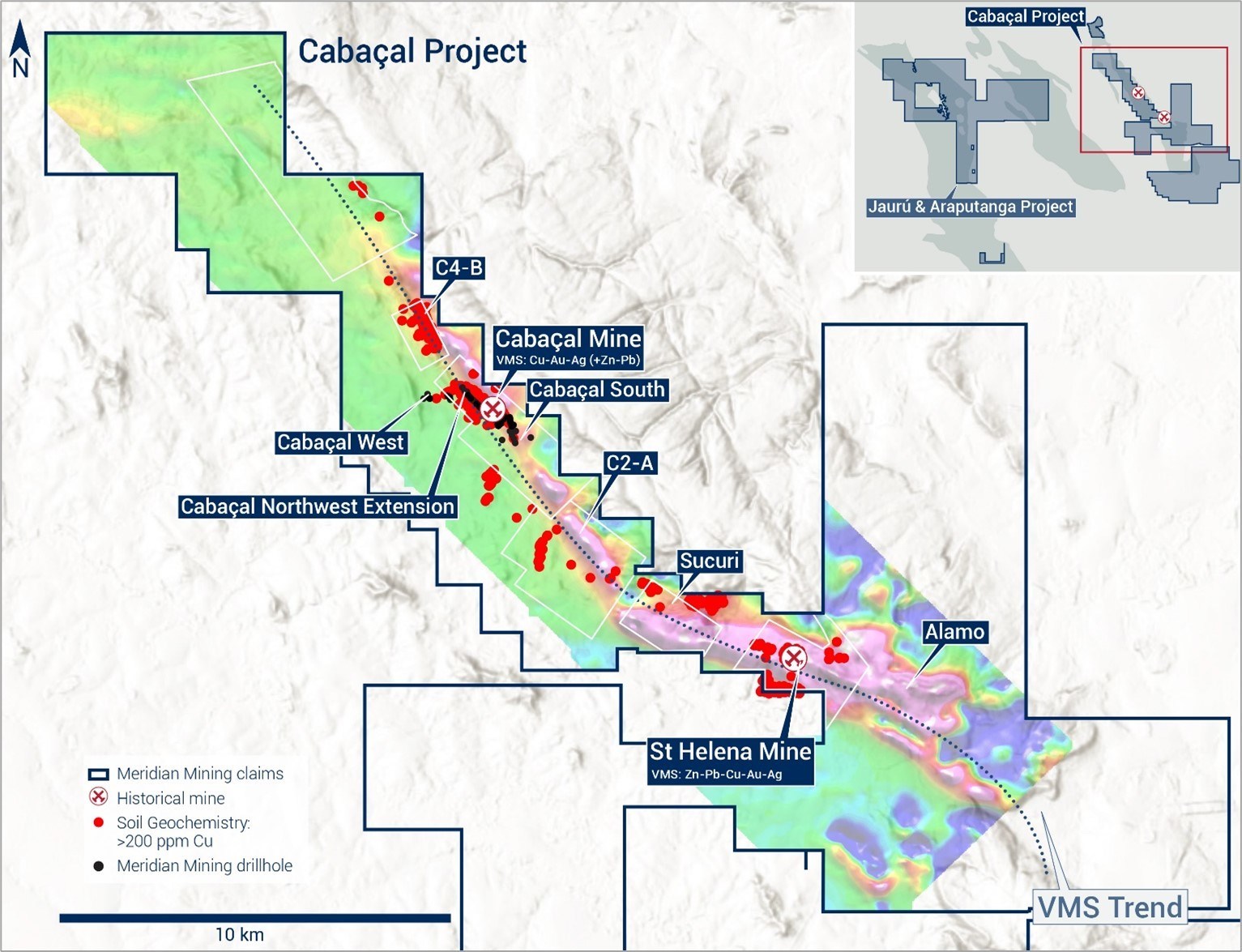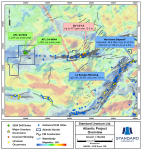
Meridian Mining (TSXV:MNO) reported that it has identified open pit potential at the historic Santa Helena mine. The company announced positive results from the evaluation of the historic underground zinc, copper, gold, silver and lead mine.
The results determined that the Santa Helena project has great potential for open pit development in the future due to its remnant massive sulfide deposit, unmined surface mineralization, open historical drill results and the late stage Carbaçal centurion gold overprint.
Dr. Adrian McArthur, CEO and President, commented, “…Our first assessment of Cabaçal’s other historic subway mine at Santa Helena is very positive. It also operated as a selective mine, focused on shallow massive sulfide lenses, but closed prematurely after the collapse of commodity prices in 2008. After the Cabaçal mine, Santa Helena is perhaps the most advanced historic prospect with potential to be developed as an open pit satellite. operation, and as with the Cabaçal mine, the mineralization at Santa Helena is well defined, starting at surface and open.”
Historical drill results will be targeted for confirmation, interbedding and lateral extensions; including:
- JUCHD031: 27.6 m @ 4.1 % CuEq* (1.6 % Cu, 1.5 g/t Au, 36.3 g/t Ag and 4.4 % Zn) of 24.9 m ;
- FSS24: 17.5 m @ 3.6 % CuEq (0.7 % Cu, 1.0 g/t Au, 25.5 g/t Ag and 7.2 % Zn) from 21.5 m
The historical resource estimate for Santa Helena (also known as Monte Cristo) was completed by SRK and submitted to Prometálica in a report dated March 30, 2007: Technical Report NI 43-101 Brazilian Resources Inc. Monte Cristo Mine. Mato Grosso State, Brazil. SRK Consulting report, project number 164802. Compiled by Nick Michael, Clay Taylor, Alva Kuestermeyer. A qualified person has not done sufficient work to classify the historical estimate as current mineral resources or mineral reserves. Meridian has not treated the resource and reserve indicated in this report as current mineral resources or mineral reserves for the purposes of National Instrument 43-101.
Santa Helena Evaluation
With Meridian’s programs at Cabaçal advancing, an initial assessment of the second historical mining center at Santa Helena is completed. Santa Helena’s trend originally formed part of BP Minerals “C2C” target, discovered as a localized gold/base metal stream sediment anomaly (Figure 1). Areas of anomalous geochemistry were followed up with a gossan search, with samples located in subcrop returning characteristic VMS geochemistry (Zn-Cu-Pb signature), many also with an elevated precious metal signature (gold: 0.8 – 16.2 g/t and silver: 2.5 – 100.2 g/t). Multiple gold-count-in-soil anomalies were detected; one extending over 400m along the western end of the deposit, and another extending over 750m to the east. Mineralization has been intersected in drilling over a strike length of 1000m. Associated base metal soil anomalies extend over 1200m, with satellite gold in soil anomalies present in offset positions to the south and east.
BP Minerals conducted three campaigns of drilling (75 holes for 10,400m), delineating a sulphide body hosted by stratigraphy very similar to the Cabaçal Mine’s, with the main units being banded cherts, felsic volcanic / volcaniclastic rocks, chloritic schists and gabbroic intrusions. The sulphide assemblage of the C2C deposit was dominated by sphalerite, with chalcopyrite, pyrrhotite, and galena. Prometálica Mineração Ltda (“Prometálica”) completed an additional 39 diamond holes for 2,479m between 1999 and 2001. The underground mine operated between 2006 to 2008, closing earlier than planned during a sharp decline in the zinc price. Monthly ROM records archived on Prometálica’s production server indicate that from October 2006 – August 2008, production amounted to 439,813t @ 6.65% Zn, 1.62% Cu, 1.77g/t Au & 43.02g/t Ag, leaving a over half of the historical reserve unexploited1.
1 The historical resource estimate for Santa Helena (also referred to as Monte Cristo) was completed by SRK and presented to Prometálica in a report dated 30 March 2007: NI 43-101 Technical Report Brazilian Resources Inc. Monte Cristo Mine. State of Mato Grosso, Brazil. Report by SRK Consulting, Project Number 164802. Compiled by Nick Michael, Clay Taylor, Alva Kuestermeyer. A qualified person has not done sufficient work to classify the historical estimate as current mineral resources or mineral reserves. Meridian has not treated the resource and reserve stated in this report as a current mineral resource or reserves for purposes of National Instrument 43–101.
Modelling was constrained by a 1% Zinc-Equivalent (ZnEq) grade shell. The ZnEq calculation was applied for reporting the estimates (ZnEq % = Zn% + (2.14 * Cu%) + (0.39 * Au ppm) + (0.007* Ag ppm); Metallurgical Recovery = 89% Zn, 89% Cu, 65% Au, 61% Ag; Au price USD 570 / oz; Ag price USD 11 / oz, Cu price USD 3.36/ lb; Zn price = 1.57 / lb). A density of 3.1 was assigned to all blocks, based on data obtained from 182 specific gravity readings on BP Minerals drill core. A block model was constructed based on block dimensions 15m x 5m x 5m. An inverse distance search method was applied with a three-pass search method for classifying blocks as measured, indicated and inferred. Resources were calculated as at December 21 2006, corrected for mining depletion and including stockpiles, at a 3.0% ZnEq cut-off grade, defining Measured and Indicated resources of 1,120,000t @ 6.20% Zn, 1.32% Cu, 1.29g/t Au, 41.65g/t Ag, and Inferred resources of 37,000t @ 5.81% Zn, 1.29% Cu, 128g/t Au, 40.94g/t Ag. Proven and probable reserves were stated as 1,188,646t @ 5.84% Zn, 1.24% Cu, 1,22g/t Au & 39.14g/t Ag. The Life of Mine Plan envisaged a five-year operation (2006 – 2011) producing at 270,000t per year.
At the moment the defined mineralization is shallow as much of the target is at depths of < 100 m below surface. Meridian still sees the potential to optimize and increase the capacity of Santa Helena for open pit development by feeding a processing plant centered on the Cabaçal operation.
Source: Meridian Mining
The Next Mid-Tier Copper and Gold Developer in Brazil
Meridian Mining is a company focused on becoming the next mid-tier copper and gold developer and producer in Brazil. The company’s flagship project is Cabaçal, an advanced stage VMS district scale Cu-Au project located in the state of Mato Grosso, discovered in 1983 by BP Minerals. The 36 km Cabaçal VMS belt hosts a large historic resource and two historic high grade selective subway mines.
The above references an opinion and is for information purposes only. It is not intended to be investment advice. Seek a licensed professional for investment advice. The author is not an insider or shareholder of any of the companies mentioned above.
If you would like to receive our free newsletter via email, simply enter your email address below & click subscribe.
CONNECT WITH US
Tweets
Tweet with hash tag #miningfeeds or @miningfeeds and your tweets will be displayed across this site.
MOST ACTIVE MINING STOCKS
Daily Gainers
 Lincoln Minerals Limited Lincoln Minerals Limited |
LML.AX | +125.00% |
      |
GCR.AX | +33.33% |
      |
CASA.V | +30.00% |
      |
AHN.AX | +22.22% |
      |
ADD.AX | +22.22% |
      |
AZM.V | +21.98% |
      |
NSE.V | +21.05% |
      |
DYG.V | +18.42% |
      |
AAZ.V | +18.18% |
      |
GLA.AX | +17.65% |

 Follow us on Twitter
Follow us on Twitter Become our facebook fan
Become our facebook fan







